Thales Alenia Space wins contracts for IRIDE radar and optical satellites
Wednesday, 05 April 2023 09:55 Thales Alenia Space, the joint venture between Thales (67%) and Leonardo (33%), has won contracts from the European Space Agency (ESA) to supply a first batch of six small satellites with synthetic aperture radars (SAR) and one satellite based on optical technology for the Italian Earth observation constellation, IRIDE. This innovative new constellation, based on a number of different sensing in
Thales Alenia Space, the joint venture between Thales (67%) and Leonardo (33%), has won contracts from the European Space Agency (ESA) to supply a first batch of six small satellites with synthetic aperture radars (SAR) and one satellite based on optical technology for the Italian Earth observation constellation, IRIDE. This innovative new constellation, based on a number of different sensing in Two views of Las Vegas
Wednesday, 05 April 2023 09:55 These two images show a large part of the city of Las Vegas and parts of its surroundings. One is a true colour representation (left) and one is a false colour representation (right).
The images were acquired by the German environmental satellite EnMAP, which captured a 41-kilometre by 122-kilometre image strip of the region on 12 July 2022. The total area is approximately 5077 square kilo
These two images show a large part of the city of Las Vegas and parts of its surroundings. One is a true colour representation (left) and one is a false colour representation (right).
The images were acquired by the German environmental satellite EnMAP, which captured a 41-kilometre by 122-kilometre image strip of the region on 12 July 2022. The total area is approximately 5077 square kilo Spotlight on Ganymede, Juice’s primary target
Wednesday, 05 April 2023 07:34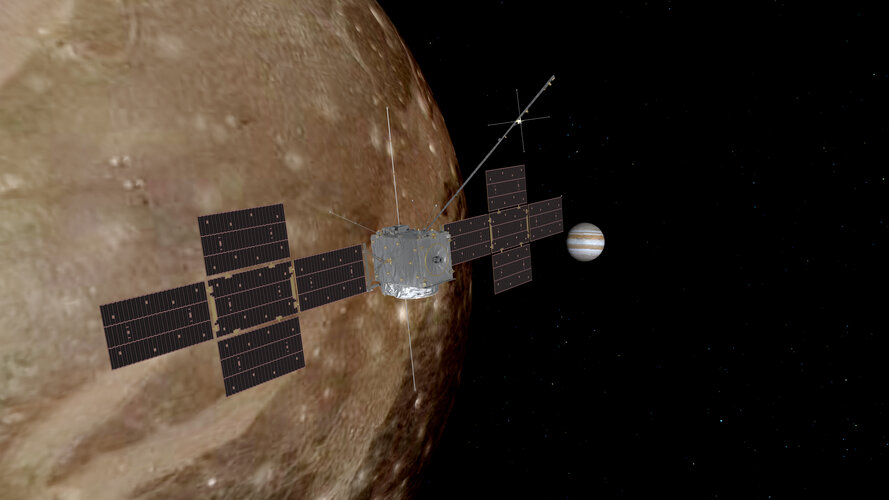
A key focus of ESA’s Jupiter Icy Moons Explorer (Juice) will be Ganymede: Jupiter’s largest moon, and an ideal natural laboratory for studying the icy worlds of the Solar System.
Juice meets Ariane 5
Wednesday, 05 April 2023 07:25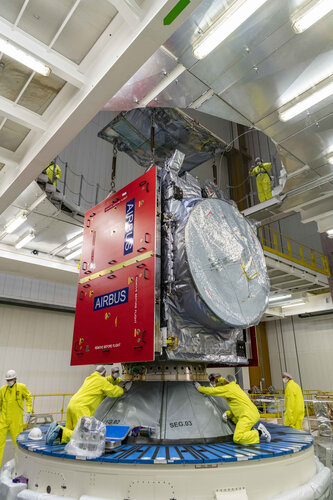
Over the past few days, Juice has been transferred to the final assembly building and mounted onto the Ariane 5 rocket that will carry it into space. These photos capture the key milestones in this process.
Apple executive Doug Beck tapped to lead the Defense Innovation Unit
Tuesday, 04 April 2023 19:24
Apple executive Doug Beck has been named as the next director of the Defense Innovation Unit (DIU), the Defense Department announced April 4.
Apex to launch first satellite in 2024
Tuesday, 04 April 2023 13:10
Small satellite manufacturer Apex will launch its first satellite next year as a demonstration of its capabilities as it prepares for large-scale production.
Arabsat blames thruster issue for temporary satellite outage
Tuesday, 04 April 2023 13:00
A thruster issue was behind a temporary outage of Arabsat’s aging Badr-6 broadcast satellite in February, according to an executive for the Saudi Arabia-based operator.
50 years after NASA's Apollo mission, moon rocks still have secrets to reveal
Tuesday, 04 April 2023 12:52
How Juice was made ready for Jupiter
Tuesday, 04 April 2023 11:10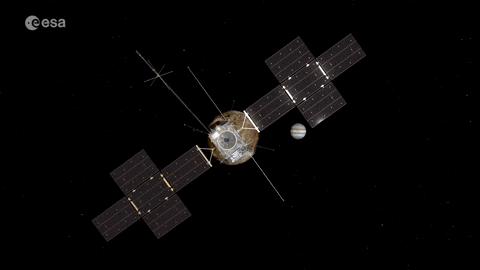
Deciding to go to Jupiter was the easy part: it’s by far the largest planet around the Sun, resembling a Solar System in its own right with its many moons, three of which may well be home to hidden oceans beneath their icy surfaces. Then came the practical question: how do we actually put together a mission to go there? It was here that ESA’s Directorate of Technology, Engineering and Quality lent its support to the Juice team, tackling numerous technical challenges that threatened to bar Europe’s way to the king of planets.
Virgin Orbit files for bankruptcy
Tuesday, 04 April 2023 11:02
Launch company Virgin Orbit filed for Chapter 11 bankruptcy April 4, having failed to achieve financial orbit after burning through more than $1 billion.
Virgin Orbit files for bankruptcy, seeks buyer
Tuesday, 04 April 2023 10:32 Virgin Orbit, the satellite launch company founded by Richard Branson, has filed for Chapter 11 bankruptcy and will sell the business, the firm said in a statement Tuesday.
The California-based company said last week it was laying off 85 percent of its employees - around 675 people - to reduce expenses due to its inability to secure sufficient funding.
Virgin Orbit suffered a major set
Virgin Orbit, the satellite launch company founded by Richard Branson, has filed for Chapter 11 bankruptcy and will sell the business, the firm said in a statement Tuesday.
The California-based company said last week it was laying off 85 percent of its employees - around 675 people - to reduce expenses due to its inability to secure sufficient funding.
Virgin Orbit suffered a major set NASA astronaut Christina Hammock Koch to become first woman to orbit the moon
Tuesday, 04 April 2023 10:32 NASA astronaut Christina Hammock Koch - a flight engineer on the International Space Station and record-holder for the longest single spaceflight by a female - will become the first woman to orbit the moon next year when the space agency launches its Artemis II mission.
Koch's name was revealed Monday as a member of the four-person crew of astronauts from the United States and Canada
NASA astronaut Christina Hammock Koch - a flight engineer on the International Space Station and record-holder for the longest single spaceflight by a female - will become the first woman to orbit the moon next year when the space agency launches its Artemis II mission.
Koch's name was revealed Monday as a member of the four-person crew of astronauts from the United States and Canada Earth's anisotropic inner core structure driven by dipole geomagnetic field: Study
Tuesday, 04 April 2023 10:32 A geomagnetic field is generated in Earth's interior and extends into outer space to protect Earth from cosmic radiation and the charged particles of solar wind. The magnetic field is generated by the convection of charged molten iron fluids in Earth's outer core.
In contrast to the convective homogenous outer core, Earth's inner core is inhomogeneous and anisotropic. The seismic velocity
A geomagnetic field is generated in Earth's interior and extends into outer space to protect Earth from cosmic radiation and the charged particles of solar wind. The magnetic field is generated by the convection of charged molten iron fluids in Earth's outer core.
In contrast to the convective homogenous outer core, Earth's inner core is inhomogeneous and anisotropic. The seismic velocity ESA's astronaut candidates start training
Tuesday, 04 April 2023 09:22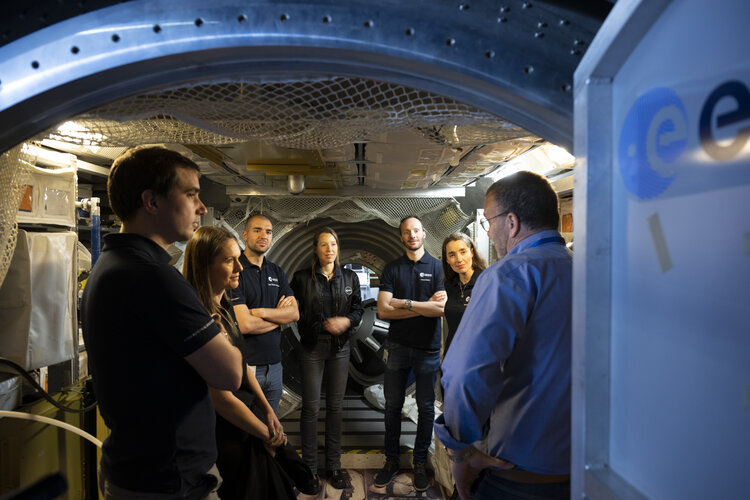
ESA welcomed its latest group of astronaut candidates yesterday at its European Astronaut Centre in Cologne, Germany, at the start of their one-year basic training to prepare for future space missions.
EO Science Strategy workshop
Tuesday, 04 April 2023 08:00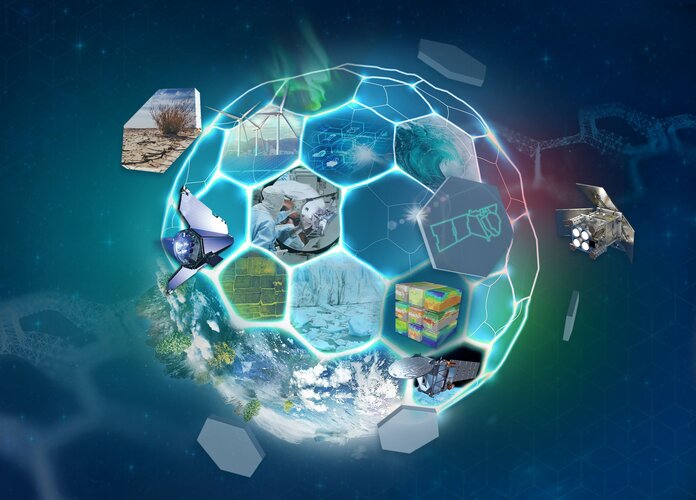
Register for Earth Observation Science Strategy workshop
19-20 June – Bruges, Belgium

